Sleepy Hollow Cemetery (Concord, Massachusetts)
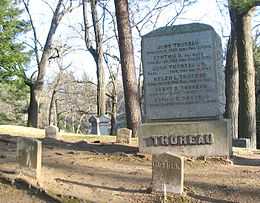 Thoreau family plot in Sleepy Hollow Cemetery | |
| Details | |
|---|---|
| Established | 1855 |
| Location | Concord, Massachusetts |
| Country | United States |
| Type |
Public |
|
Sleepy Hollow Cemetery | |
 Cemetery site in U.S. state of Massachusetts | |
| Location | 34A Bedford St., Concord, Massachusetts |
| Coordinates | 42°27′48″N 71°20′40″W / 42.46333°N 71.34444°WCoordinates: 42°27′48″N 71°20′40″W / 42.46333°N 71.34444°W |
| Area | 31.6 acres (12.8 ha) |
| Built | 1823 |
| Governing body | Local |
| NRHP Reference # | 98000991[1] |
| Added to NRHP | August 19, 1998 |
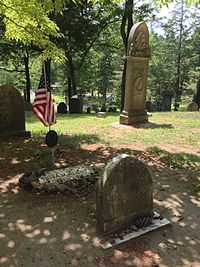
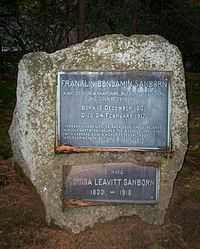
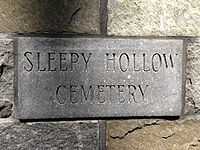
Sleepy Hollow Cemetery is a cemetery located on Bedford Street near the center of Concord, Massachusetts. The cemetery is the burial site of a number of famous Concordians, including some of the United States' greatest authors and thinkers, especially on a hill known as "Author's Ridge."
History
Sleepy Hollow was designed in 1855 by noted landscape architects Cleveland and Copeland, and has been in use ever since. It was dedicated on September 29, 1855; Ralph Waldo Emerson gave a dedication speech and would be buried there decades later.[2] Both designers of the cemetery had decades-long friendships with many leaders of the Transcendentalism movement, and their design reflects that.
"Sleepy Hollow was an early natural garden designed in keeping with Emerson's aesthetic principles," writes Joachim Wolschke-Bulmahn in his Nature and Ideology. In 1855, landscape designer Robert Morris Copeland delivered an address he entitled The Usefull [sic] and The Beautiful, tying his principles of naturalistic, organic garden design to Emerson's Transcendentalist principles. Shortly, afterward, Copeland and his partner were retained by the Concord Cemetery Committee, of which Emerson was an active member, to design a cemetery for the growing community.
On September 29, 1855, Emerson delivered the opening address of the cemetery's consecration.[3] In it he lauded the designers' work. "The garden of the living," said Emerson, was as much for the benefit for the living, to communicate their relationship to the natural world, as it was to honor the dead. By situating the monuments to the dead within a natural landscape, the architects conveyed their message, said Emerson. A cemetery could not "jealously guard a few atoms under immense marbles, selfishly and impossibly sequestering [them] from the vast circulations of nature [which] recompenses for new life [each decomposing] particle."[4]
Known as Sleepy Hollow for some 20 years prior to its use as a cemetery, the newly-consecrated landscape would, Emerson told his audience that September day in Concord, "When these acorns, that are falling at our feet, are oaks overshadowing our children in a remote century, this mute green bank will be full of history: the good, the wise, and the great will have left their names and virtues on the trees... will have made the air tuneable and articulate."
To realize their vision, Emerson noted that the cemetery's designers had fitted the walks and drives into the site's natural amphitheater. They also left much of the original natural vegetation in place, instead of removing it and replanting with ornamental shrubs, as was often the case. Several years after Emerson's address, a visitor to the new cemetery noted the abundance of wild plants such as woodbine, raspberry, and goldenrod, as well as the natural moss and roots of pine trees which were left in situ by the designers.[5]
The Melvin Memorial, also known as Mourning Victory, sculpted by Daniel Chester French marks the grave of three brothers killed in the Civil War.
People are still being buried there. The back of the newer portion of the cemetery leads to a path system which connects to the Great Meadows National Wildlife Refuge.
Notable burials
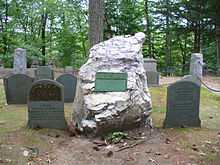
- The Alcott family, including Amos Bronson Alcott (Transcendentalist, philosopher, educator), Abby May (Wife of Amos Bronson Alcott), and their daughter Louisa May Alcott (author of Little Women and others)
- Ephraim Wales Bull (inventor of the Concord Grape)
- Arthur R. Bethke (Concord Oil Owner, US Army Captain, Bethke Cancer Center)
- William Ellery Channing (Transcendentalist and poet)
- Ralph Waldo Emerson, American Transcendentalist, essayist, lecturer, and poet
- Daniel Chester French (sculptor of the Lincoln Memorial)
- Nathaniel Hawthorne (author of The Scarlet Letter and others)
- Sophia Hawthorne (wife of Nathaniel Hawthorne)
- George Frisbie Hoar (19th-century politician)
- Richard Marius (Reformation historian and Southern novelist)
- Ralph Munroe (yacht designer and pioneer of South Florida)
- Elizabeth Peabody (education reformer)
- Franklin Benjamin Sanborn (author and social reformer)
- Henry David Thoreau (American Transcendentalist, philosopher, essayist, and lecturer)
- Mary Colman Wheeler (founder of the Wheeler School)
- George Washington Wright (California's first representative in Congress)
See also
- List of United States cemeteries
- National Register of Historic Places listings in Concord, Massachusetts
References
- ↑ "National Register Information System". National Register of Historic Places. National Park Service. 2010-07-09.
- ↑ McAleer, John. Ralph Waldo Emerson: Days of Encounter. Boston: Little, Brown and Company, 1984: 664. ISBN 0-316-55341-7.
- ↑ Emerson's address, entitled An Address to the Inhabitants of Concord at the Consecration of Sleepy Hollow, is written in Emerson's own hand and is part of the Emerson Papers at Houghton Library, Harvard University. The address contains crossed-out revisions in the text, as edited by the author.
- ↑ Nature and Ideology: Natural Garden Design in the Twentieth Century, Joachim Wolschke-Bulmahn, Published by Dumbarton Oaks, 1997, ISBN 0-88402-246-3
- ↑ Nature and Ideology: Natural Garden Design in the Twentieth Century, Joachim Wolschke-Bulmahn, Published by Dumbarton Oaks, 1997, ISBN 0-88402-246-3
External links
| Wikimedia Commons has media related to Sleepy Hollow Cemetery (Concord). |
| |||||||||||||||||||||||||||||||||||||||||||||||||||||||
